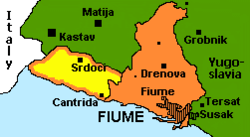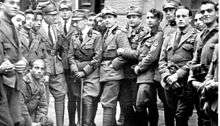Italian Regency of Carnaro
The Italian Regency of Carnaro (Italian: Reggenza Italiana del Carnaro) was a self-proclaimed state in the city of Fiume (now Rijeka, Croatia) led by Gabriele d'Annunzio between 1919 and 1920. It is also known by its lyrical name in Italian: Endeavor of Fiume (Impresa di Fiume).
Italian Regency of Carnaro Reggenza Italiana del Carnaro | |||||||||
|---|---|---|---|---|---|---|---|---|---|
| 1919–1920 | |||||||||
 Flag
 Emblem
| |||||||||
Motto: QUIS CONTRA NOS? ("Who is against us?") | |||||||||
 Map of the "Italian Regency of Carnaro" (later the Free State of Fiume). | |||||||||
| Status | Unrecognized entity seeking unification with Italy | ||||||||
| Capital | Fiume | ||||||||
| Common languages | Italian | ||||||||
| Government | Provisional authoritarian republic | ||||||||
| Comandante | |||||||||
• 1919-1920 | Gabriele D'Annunzio | ||||||||
| Legislature | Arengo del Carnaro | ||||||||
| Consiglio degli Ottimi | |||||||||
| Consiglio dei Provvisori | |||||||||
| Historical era | Interwar period | ||||||||
• Coup d'état and establishment | 12 September' 1919 | ||||||||
• Modus Vivendi Plebiscite | 18 December 1919 | ||||||||
• Constitution | 8 September 1920 | ||||||||
• Treaty of Rapallo | 12 November 1920 | ||||||||
• Conquered | 30 December 1920 | ||||||||
| |||||||||
| Today part of | |||||||||
Impresa di Fiume

During World War I (1914–1918), Italy made a pact with the Allies, the Treaty of London (1915), in which it was promised all of the Austrian Littoral, but not the city of Fiume. After the war, at the Paris Peace Conference, 1919, this delineation of territory was confirmed, with Fiume (or Rijeka) remaining outside of Italian borders and amalgamated into the Kingdom of Serbs, Croats and Slovenes (later Yugoslavia).
As a nationalist, Gabriele d'Annunzio was angered by what he considered to be the surrender of an Italian city. On 12 September 1919, he led a force that was about 2,600-strong and drawn mostly from former or serving members of the Granatieri di Sardegna brigade of the Royal Italian Army, as well as Italian nationalists and irredentists. Many members of Annunzio's force were reputedly veterans of the Battles of the Isonzo.
They were successful in seizing control of the city, and forced the withdrawal of the Allied (US, British and French) occupying forces. The march from Ronchi dei Legionari to Fiume, by Annunzio's so-called "legionaries", became known as the Impresa di Fiume ("Fiume endeavor", or "Fiume enterprise").

On the same day, d'Annunzio announced that he had annexed the territory to the Kingdom of Italy. He was enthusiastically welcomed by the ethnic Italian portion of the population of Fiume.[1] This was opposed by the Italian government, which attempted to pressure d'Annunzio to withdraw. The government initiated a blockade of Fiume and demanded that the plotters surrender. During his time in Fiume in September 1919, Filippo Tommaso Marinetti praised the leaders of the impresa as "advance guard deserters" (disertori in avanti).
Modus vivendi
On December 8, the Italian government proposed a modus vivendi recognizing Fiume's desire for annexation and promising they would "only consider acceptable a solution consonant with that which Fiume declared to desire."[2] On December 11 and 12, d'Annunzio met with General Pietro Badoglio to try and obtain more concessions. Badoglio refused, and d'Annunzio said he would submit the modus vivendi to the Italian National Council of Fiume. The National Council accepted the proposal on December 15.[3]
After the National Council's decision, d'Annunzio addressed a crowd of five thousand people and incited them to reject the modus vivendi, promising to put the issue to a plebiscite. The plebiscite was held on December 18, and despite violence and irregularities the results were overwhelmingly in favour of the modus vivendi. D'Annunzio nullified the results, blaming the violence at the polls, and announced he would make the final decision himself. He ultimately rejected the modus vivendi. According to Michael Ledeen, d'Annunzio made this decision because he distrusted the Italian government and doubted their ability to deliver on their promises.[4]
Regency
.svg.png)
On 8 September 1920, d'Annunzio proclaimed the city to be under the Italian Regency of Carnaro with a constitution foreshadowing some of the later Italian Fascist system, with himself as dictator, with the title of Comandante.
The name Carnaro was taken from the Golfo del Carnaro (Kvarner Gulf), where the city is located. It was temporarily expanded by d'Annunzio in order to include the island of Veglia. The only other State to recognize the Italian Regency of Carnaro was the Soviet Union.
Constitution
The Charter of Carnaro (Carta del Carnaro in Italian) was a constitution that combined anarchist, proto-fascist, and democratic republican ideas. D'Annunzio is often seen as a precursor of the ideals and techniques of Italian fascism. His own explicit political ideals emerged in Fiume when he coauthored the charter with syndicalist Alceste De Ambris. De Ambris provided the legal and political framework, to which d'Annunzio added his skills as a poet. The charter designates music a "religious and social institution."
Corporations
The constitution established a corporatist state,[5] with nine corporations to represent the different sectors of the economy, where membership was mandatory, plus a symbolic tenth corporation devised by d'Annunzio, to represent the "superior individuals" (e.g. poets, "heroes" and "supermen"). The other nine were as follows:
- Industrial and Agricultural Workers
- Seafarers
- Employers
- Industrial and Agricultural Technicians
- Private Bureaucrats and Administrators
- Teachers and Students
- Lawyers and Doctors
- Civil Servants
- Co-operative Workers
Executive
The executive power would be vested in seven ministers (rettori):
- Foreign Affairs
- Treasury
- Education
- Police and Justice
- Defense
- Public Economy
- Labor
Legislature
The legislative power was vested in a bicameral legislature. Joint sessions of both councils (Arengo del Carnaro) would be responsible for treaties with foreign powers, amendments to the constitution, and appointment of a dictator in times of emergency.
- Council of the Best (Consiglio degli Ottimi) – Elected by universal suffrage for a 3-year term – 1 councilor per 1000 population Responsible for legislation concerning civil and criminal justice, police, armed forces, education, intellectual life and relations between the central government and communes
- Council of Corporations (Consiglio dei Provvisori) – 60 members chosen by nine corporations for a 2-year term – Responsible for laws regulating business and commerce, labor relations, public services, transportation and merchant shipping, tariffs and trade, public works, medical and legal professions
Judiciary
Judicial power vested in the courts
- Supreme Court (Corte della Ragione, literally "Court of Reason")
- Communal Courts (Buoni Uomini, literally "Good Men")
- Labour Court (Giudici del Lavoro)
- Civil Court (Giudici Togati, literally "Judges in toga")
- Criminal Court (Giudici del Maleficio, where "Maleficio" is a literary form for "wrongdoing", but it can also mean "curse")
Impact
Benito Mussolini was influenced by the Fascist portions of the constitution, and by d'Annunzio's style of leadership as a whole. D'Annunzio has been described as the John the Baptist of Italian Fascism,[6] as virtually the entire ritual of Fascism was invented by D'Annunzio during his occupation of Fiume and his leadership of the Italian Regency of Carnaro.[7] These included the balcony address, the Roman salute, the cries of "Eia, eia, eia! Alala!" taken from the Achilles' cry in the Iliad, the dramatic and rhetorical dialogue with the crowd, and the use of religious symbols in new secular settings.[6] It also included his method of government in Fiume: the economics of the corporate state; stage tricks; large emotive nationalistic public rituals; and blackshirted followers, the Arditi, with their disciplined, bestial responses and strongarm repression of dissent.[8] He was even said to have originated the practice of forcibly dosing opponents with large amounts of castor oil, a very effective laxative, to humiliate, disable or kill them, a practice which became a common tool of Mussolini's blackshirts.[9][10][11]
Demise
The approval of the Treaty of Rapallo on 12 November 1920 turned Fiume into an independent state, the Free State of Fiume.
D'Annunzio ignored the Treaty of Rapallo and declared war on Italy itself. On 24 December 1920 the Italian army and a bombardment by the Royal Italian Navy forced the Fiuman legionnaires to evacuate and surrender the city.
The Free State of Fiume would officially last until 1924, when Fiume was formally annexed to the Kingdom of Italy under the terms of the Treaty of Rome. The administrative division was called the Province of Carnaro.
See also
- Doctrine of Fascism
- Gabriele d'Annunzio
- List of governors and heads of state of Fiume
- Postage stamps and postal history of Fiume
- Free State of Fiume
- Italia irredentia
- Pietro Micheletti
- Rijeka
Notes
- Images of Fiume welcoming d'Annunzio Archived 2011-03-16 at the Wayback Machine
- Ledeen, Michael A. (2002). D'Annunzio: The First Duce. New Brunswick, NJ: Transaction Publishers. p. 134.
- Ledeen, Michael A. (2002). D'Annunzio: The First Duce. New Brunswick, NJ: Transaction Publishers. pp. 135–136.
- Ledeen, Michael A. (2002). D'Annunzio: The First Duce. New Brunswick, NJ: Transaction Publishers. pp. 136–137.
- Parlato, Giuseppe (2000). La sinistra fascista (in Italian). Bologna: Il Mulino. p. 88.
- Ledeen, Michael Arthur (2001). "Preface". D'Annunzio: the First Duce (2, illustrated ed.). Transaction Publishers. ISBN 9780765807427.
- Paxton, Robert O. (2005). "Taking Root". The Anatomy of Fascism. Vintage Series (reprint ed.). Random House, Inc. pp. 59–60. ISBN 9781400040940.
- The United States and Italy, H. Stuart Hughes, Harvard University Press, Cambridge, MA, 1953, pp. 76 and 81–82.
- Cecil Adams, Did Mussolini use castor oil as an instrument of torture?, The Straight Dope, 22 April 1994. Accessed 6 November 2006.
- Richard Doody, "Stati Libero di Fiume – Free State of Fiume". Archived from the original on 8 March 2009. Retrieved 24 August 2002., The World at War.
- Cali Ruchala, ""Superman, Supermidget": the Life of Gabriele D'Annunzio, Chapter Seven: The Opera". Archived from the original on 10 February 2005. Retrieved 6 November 2006.CS1 maint: BOT: original-url status unknown (link), Degenerate magazine, Diacritica (2002).
External links
| Wikisource has original text related to this article: |
- (in English)The Charter of Carnaro
- https://web.archive.org/web/20180509072247/http://www.reakt.org/fiume/index_2.html
- https://web.archive.org/web/20180124083210/http://www.reakt.org/fiume/charter_of_carnaro.html
- Richard Doody. "STATI LIBERO di FIUME – FREE STATE of FIUME". Archived from the original on 22 December 2007.
- https://web.archive.org/web/20070212090316/http://www.crwflags.com/fotw/flags/hr-fiume.html
- http://worldatwar.net/nations/other/fiume/
- https://web.archive.org/web/20090715162114/http://www.karr.net/Constitution_of_Fiume/etexts.htm
.jpg)